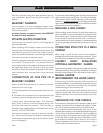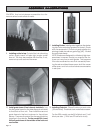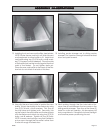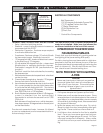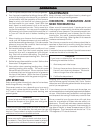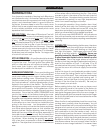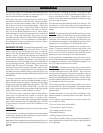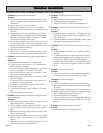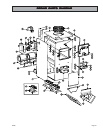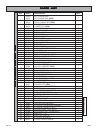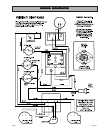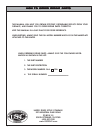
Page 18 USSC
If, however, there is no flame then the fire needs more
air from the bottom (unless it is near the end of its
burn cycle and needs to be recharged).
Only when the coal is burned down to half its origi-
nal depth is it time to add fresh coal. When doing so,
open your stove pipe damper, which will allow the
fire to burn off any accumulated gases. Open the
feed door, and with a small rake, hoe or hooked
poker pull the glowing coals to the front of the fire-
box. Try not to disturb the fire too much. Next, add a
fresh charge to the back being careful not to seal off
the top. Close the feed door but leave the spin
damper open for a few minutes until the volatile gases
have burned off. It is not necessary to shake down
the ashes each time you refuel your furnace. Experi-
ence will be your best teacher.
BANKING THE FIRE: For extended operation, such
as overnight, you will need to bank the fire. To do so
heap coal up along the sides and back of the fire-
box so that the fire gradually burns it over a longer
period of time. You will also reduce the intensity of
the fire without letting it go out. Follow the same pro-
cedure as for refueling. If possible, avoid shaking, as
a heavier layer of ash will help reduce the intensity of
the fire during this time. After loading, let the fire es-
tablish itself for about 30 minutes. Then close your
damper to the point where the house does not be-
come too cold. It is important that you begin bank-
ing early enough before retiring or leaving that you
can make necessary adjustments after the fire is well
established.
To revive a coal fire that is almost out, you should (1)
open the ash door and stove pipe damper to get a
good draft through the grate. (2) place a thin layer
of dry coal over the entire top of the fire. DO NOT
POKE OR SHAKE THE FIRE AT THIS TIME! (3) after the
fresh coal has become well ignited shake the grate
(just a little) and you will be ready to refuel.
DO NOT burn coke, charcoal, high volatile bitumi-
nous coal, sub bituminous, lignite or cannel coal
(sometimes called channel coal or candle coal).
NEVER burn wax or chemically impregnated sawdust
logs - their intended use is for fireplaces only. NEVER
fill your stove or furnace above the firebrick or cas
iron liner.
SHAKING: Shaking should be done only when there
is a hot fire.
The frequency of shaking will depend on the degree
of burning. Shaking should be done at least once a
day and preferably twice a day.
Best results from shaking the rocker grates will occur if
short "choppy" strokes are used rather than long, even
strokes.
The amount of shaking is critical. Too little or too
much of both can result in the extinguishing of a fire
due to blocked air flow. The proper amount nor-
mally occurs when red coals first start to drop through
onto the bed of ashes.
No furnace ever should be "poled" from the top. This
can lead to clinker formation and compacting of
the coal and ashes, which results in clogged air pas-
sages.
ASHES: Ashes never should be allowed to accumu-
late in the ash pit so that they in any way impede the
flow of combustion air to the fire. Excess ash accu-
mulation can cause the fire to go out and also can
cause severe damage to the grates because of the
absence of a cooling flow of air beneath them.
Ashes always should be emptied into a metal con-
tainer. Coals can remain hot many hours after a fire
is out. Coal ashes should not be put on gardens as
they do not contain beneficial minerals like wood
ashes, and may cause ground water pollution.
Coal produces considerably more ash than wood,
so the intervals between emptying are much shorter.
For equal heat output, coal will produce seven (7) to
ten (10) times more ash than wood.
CLINKERS: Clinkers can occur in any coal furnace
during the process of burning. These are hard pieces
of fused ash that form in the firebox. They can be-
come hard and large in size and, therefore, cannot
be shaken through the grates in a coal stove. When
there is an appreciable accumulation, the fire will go
out because insufficient air is allowed to pass through
the clinkers to the burning coal.
Once large clinkers have formed, they can be re-
moved only from above the grates. This usually means
the fire must be allowed to go out before they can
be removed.
Clinkers formation can occur from a number of dif-
ferent causes or a combination of causes. Some of
these are:
• Poor quality coal-excess ash content and/or too
low a heat of fusion.
• Too hot a fire (too much draft).
• Too shallow a bed of coals.
• Too deep a bed of coals.
• Excessive Shaking.
• Poking the fire from the top.
• Too little air (draft) after a long, hot fire (caused by
rapid adjustment of draft from a very high setting to
a low setting).
OPERAOPERA
OPERAOPERA
OPERA
TIONTION
TIONTION
TION



